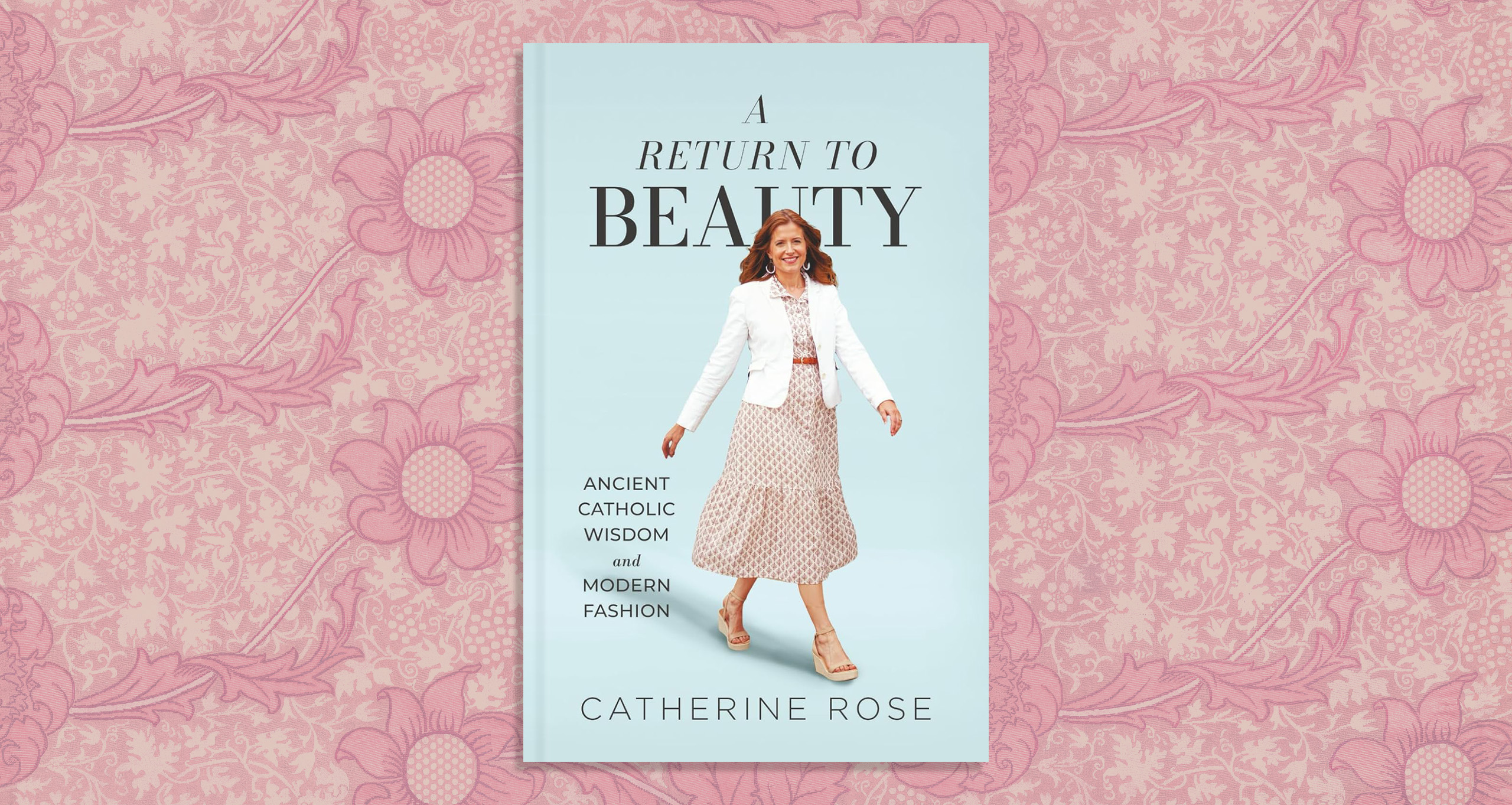Exclusive Interview with the Author of “A Return to Beauty”
Published on September 30, 2025

Fashion philosophy has become an extreme sport in the twenty-first century. Today, “modest” can mean any number of things, from being covered head to toe to showing only a little cleavage. What is true modesty? How much is “too much” when it comes to baring your body?
Questions of modesty inevitably turn into questions about the sexes and our relationship to each other, ourselves, and the way we dress. Are women responsible for men’s chastity? Is femininity naturally synonymous with weakness? And what’s the deal with pants?
Catherine Rose, mother, speaker, and promoter of true modesty in young Catholic women, strives to answer these questions with her book A Return to Beauty: Ancient Catholic Wisdom and Modern Fashion. I recently sat down with her to continue the conversation.
Called by God
Catherine’s smiling face greeted me warmly as we began our conversation. “How did you come to write this book?” I asked.
Catherine smiled and stated that she had not always dressed so modestly. “I had this big conversion earlier in my life, a part of which was moving away from presenting my body in a demeaning way.”
But after returning to her faith, Catherine found herself at a loss as to how to present herself:
“I had gone to the Catechism wanting to know how Catholic women should dress… I figured it must be in the Catechism! However, what was there was pretty nebulous, so I thought it must just be an internal state, that if I don’t intend to expose my body in a way that would induce someone to look at me and see only my sexual value, then that is modesty.”
So Catherine wore skirts to Mass, but otherwise didn’t think that much about clothing. Then one day, she had a profound experience in Adoration that changed her life. She heard God telling her to wear dresses and skirts… a message that surprised me almost as much as it surprised Catherine.
“When I was in adoration and I had this experience, it was really unexpected… My first question was: Why does it matter if women wear skirts and dresses? And secondly: I can’t do that!” She laughed a little as she said it, but then grew sober as she continued, “But I love you [God] and I will obey.”
The psychology of skirts
In her book, Catherine touches on the psychological impact that dress has on a person. I wanted to know more.
“The reason I stopped wearing pants was because of this call from God in adoration. And it was perplexing to me, but I did it out of obedience,” she recounted.
“That first summer was difficult because I had to get rid of my pants and start to find skirts and dresses. I was also nursing, so that’s an extra difficulty! It all felt very strange at first, but what I began to notice was that there was something internally that changed.”
She continued:
“I moved with more awareness. I felt pretty wherever I went. When a woman feels pretty, she feels self-confident. Oftentimes, I would feel a little overdressed for a mommy play date, but then if I had to go somewhere else, I would feel properly dressed.”
The clothing Catherine wears is not radically different, or even a costume: “I was not overdressed in a prom dress, but certainly I was dressed nicer than the moms in running shorts.”
“It is transformative inside,” Catherine continued, “and it makes me, as a woman, more aware of my interior life.”
According to Catherine, when a woman appropriate clothing, it reflects something about her dignity and identity as a woman. She continued, “There is something special about a woman; she’s made to be a mystery in the world. She is the garden enclosed. She is that sealed fountain in a world that is so increasingly violent. Our world is so harsh and rough and violent.. It’s a devotion, a piety, that I wear this intentionally to witness who and what a woman is in a world that’s also very confused.”
No pants?
Catherine explained that her position on “no pants” (except for gardening and horseback riding) was a personal call from God and not a condemnation of others.
“All I can say is that for me,” Catherine explained, “it does elevate my life. Also, I think it’s good to compare pants and skirts. The skirt or the dress is always going to be nicer.” She laughed a little and then added, “We wear wedding dresses, we don’t wear wedding pants. If I’m going to go to prom, I’ll wear a dress. I don’t wear a pantsuit because there’s something more beautiful about a long flowing dress.”
But it’s not all about the cultural standards for women’s fashion and formality. There’s a spiritual element as well.
“There’s something in us [women] that delights in our beauty for the sake of the lover, like in Song of Songs. My daughter Josephine, who passed away when she was little, would put on her tutu and dance for my husband, because she knew that her father delighted in her.”
Just as Josephine danced for her father and delighted him, so too a well dressed woman delights her heavenly father with her simplicity and modesty. God, the lover of our hearts, loves his daughters to be beautiful and at peace with themselves. Dressing in a way that highlights and even emphasizes femininity in a modest way delights God and those who love us.
What about men?
This led me to my next question – what about the men? If our dress is not just for us, does that mean we are responsible for a man’s virtue? That doesn’t seem right.
Catherine responded, “Of course, there was this wound at the very beginning between women and men. And that gave rise to this battle of the sexes… which is this lack of trust of the other and this desire for women to control men.”
She was referencing Genesis, when God says to Eve after the fall: “In pain you shall bring forth children, yet your desire shall be for your husband, and he shall rule over you.” (Genesis 3:16)
“What followed was that women want to control men and men tend to want to own women as well and treat them like cattle,” Catherine explained. “There’s inherently this resentment between the sexes and this competition.”
It takes two to tango
However, the Catholic Church does not leave women in that state. Catherine continues, “Christianity comes in and says we are brothers and brothers and sisters in Christ. “Husbands love your wives and…wives love your husbands.”
“The genius of the Catholic Church is that it gives a ‘both and.’ It tells the men to take custody of their eyes – do not look at a woman to lust after her – but also tells women to be kind to their brothers.” Catherine then referenced 1 Corinthians 13, in which Paul avoids eating meat not because it is sinful, but out of charity, so as not to offend his brother.
According to Catherine, modesty for women is an act of charity towards men.
“Most guys are having to work really hard to guard their eyes,” Catherine explained. “My husband says it’s like walking through a minefield. Not that the woman’s body is bad, so he wants to not see it, but he wants to not have a physical response that he can’t control. Good men have to work really hard, and we should support them in that.”
Is womanhood weakness?
My last question for Catherine stemmed from a cultural wariness of femininity that I have noticed in our society. Many women see womanhood, modesty, and feminine appearance as a kind of weakness – something that will inevitably be abused.
“The answer to that really is virtue theory and old movies,” she replied. When I laughed, she doubled down: “No, I’m serious! If you watch John Wayne and Kathleen O’Hara together, this interplay is shown very clearly.”
“With the virtues, prudence, justice, temperance, and fortitude, women are not just like little passive flowers that the world can simply roll over. We have fortitude.”
She added, “Kathleen O’Hara in The Quiet Man, for example, she’s a fighter. She’s feisty and she’s receptive. She makes John Wayne work for her, and she throws up obstacles because she wants to make sure that he is a man worthy to enter her gates.”
“Receptivity and hospitality are different from a passive open door to whoever wants to come in and do what they will with me. I mean that sexually, but also I mean that emotionally. Proper receptivity and proper hospitality depend upon a good deal of self-respect and self-protection. Not just anybody can come into my castle – my soul, my emotions, and ultimately my body in marriage. Modesty, therefore, is another kind of protection, a kind of armor for women to guard those who enter into their mystery.
“You want to always be looking for ways that you can deepen that mystery of womanhood. Show your loveliness and your receptivity, but show the deepest parts of yourself only to a man who’s worthy of you.”
Dress to Impress
It can be difficult to know where to begin with modern clothing. What does modesty look like in our age of leggings and crop tops? Are you at the beginning of your fashion journey? Do you want to know more about Church teaching on female dress? If you want to be more intentional about your dress but don’t know where to start, Catherine’s book is a good option.
The way we present ourselves as Catholic women is important, not only for the world and our brothers in Christ who see us, but also for our own internal sense of ourselves before God. Modesty, guarding what is sacred, should be a priority for women today.
Catherine’s book, and our subsequent conversation, gave me a lot to think about. While I may not be giving up my pants just yet, I have already become more intentional about what I wear and the effect it has on myself and others.




Catherine is the best! Get her book. Great wisdom.
FYI It’s Maureen O’Hara, not Kathleen